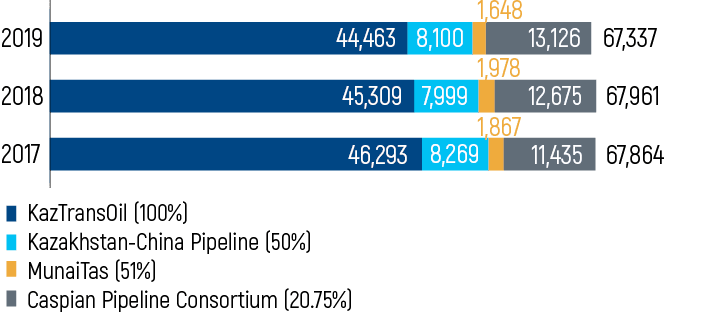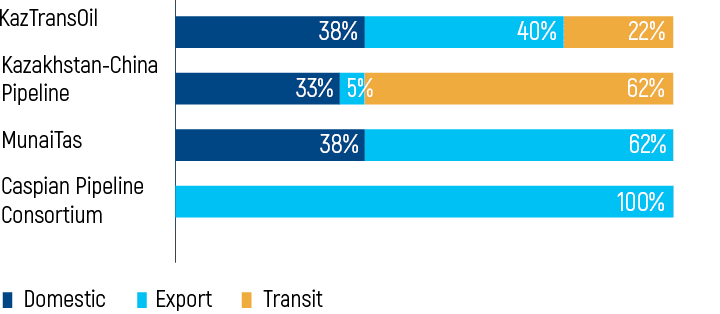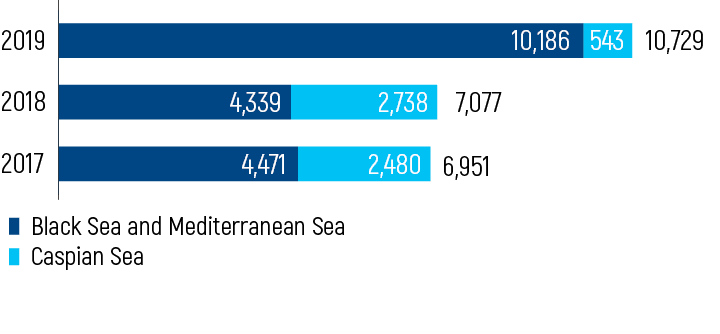Oil Transportation
KMG completed the construction of an oil transportation infrastructure to supply hydrocarbons to export markets. Medium-term priorities:
- Increase existing capacity utilisation by making KMG’s oil transportation systems more attractive and competitive
- Control over operating costs.
| Trunk pipeline transportation | Marine fleet transportation | ||||
|---|---|---|---|---|---|
| Management company | KazTransOil (KTO) | Kazakhstan-China Pipeline (KCP) | MunaiTas (MT) | Caspian Pipeline Consortium (CPC) | Kazmortransflot (KMTF) |
| Interest | KMG: 90%10% of shares of KTO are owned by minority shareholders who acquired them within the "People's IPO" program. | KazTransOil: 50% | KazTransOil: 51% | KMG: 20.75% | KMG: 100% |
| Transportation volume (net to KMG) in 2019, thous. tonnes | 44,463Since KTO is fully operated by KMG, transportation volumes are being reported for 100%. | 8,100 | 1,648 | 13,126 | 10,729 |
| Key destinations | Export to Europe and China, domestic market | Export to China, domestic market | Export to China, domestic market | Export to Europe | Export to Europe |
| Key routes | Kazakhstan’s refineries; Uzen — Atyrau—Samara; port of Aktau; oil transshipment to the CPC and Atasu —Alashankou pipelines | Atasu —Alashankou; Kenkiyak-Kumkol | Kenkiyak — Atyrau | Tengiz — Novorossiysk | Black Sea and Mediterranean Sea; Caspian Sea |
| Total length, km | 5,378 | 1,759 | 449 | 1,510 | n/a |
Pipeline infrastructure
Kazakhstan’s pipeline infrastructure is owned by “KazTransOil” JSC, its two joint ventures (“Kazakhstan-China Pipeline” LLP and “MunaiTas” North-West Pipeline Company LLP) and the “Caspian Pipeline Consortium”. The existing pipeline infrastructure in Kazakhstan has adequate potential to support increased oil transportation volumes from promising projects.
KMG's oil pipeline network
KMG’s oil pipeline network
“KazTransOil” JSC (KTO) is the national operator of the trunk oil pipeline of the Republic of Kazakhstan. The company owns an extensive network of trunk oil pipelines with a total length of 5,378 km, to which virtually all oil fields in Kazakhstan are connected. The Company transports oil to Kazakhstan’s four major refineries, pumps oil for export via the Atyrau — Samara pipeline, tranships oil to the CPC and Atasu — Alashankou export pipelines, ships oil to tankers in the port of Aktau and by rail. Oil transportation via trunk oil pipelines is supported by 36 oil pumping stations, 67 heaters, and a tank farm for oil storage with a total capacity of 1.4 mln m3. “KazTransOil” JSC also provides operation and maintenance services for the trunk oil pipelines of “Kazakhstan-China Pipeline” LLP, “MunaiTas” North-West Pipeline Company LLP, “Karachaganak Petroleum Operating B.V.”, “Caspian Pipeline Consortium-K” JSC, and “Turgai Petroleum” JSC, as well as for the trunk water line of Main Waterline LLP.
“Kazakhstan-China Pipeline” LLP is the owner of the Atasu — Alashankou (965 km) and Kenkiyak — Kumkol (794 km) oil pipelines. The company transports Kazakhstan’s oil and transit Russian oil to China and to the domestic market.
“MunaiTas” North-West Pipeline Company LLP is the owner of the 449 km Kenkiyak — Atyrau oil trunk pipeline. In 2018, the company started implementing the Kenkiyak-Atyrau pipeline reverse project to support supplies of West Kazakhstan’s oil to domestic refineries and to compensate production decline in Aktobe and Kyzylorda regions, as well as exports to China totalling up to 6 mln tonnes per year. The project cost is KZT 28.6 bln. The start of oil flow reversal is scheduled for the second half of 2020.
“Caspian Pipeline Consortium” (CPC) is international oil transportation project involving Russia, Kazakhstan and the world’s leading industry players. It was established for the construction and operation of a 1,510 km trunk pipeline (452 km are within Kazakhstan). The CPC oil pipeline is a priority export route for Kazakhstan’s oil supplies, connecting Kazakhstan’s Tengiz oil field with the Yuzhnaya Ozereyevka oil terminal on the Black Sea (near the port of Novorossiysk). Oil transportation via the CPC pipeline is supported by 15 oil pumping stations, an oil storage tank farm with a total capacity of 1.3 mln m3 and three single-point moorings.
In view of the anticipated increases in oil production from Tengiz and Kashagan, in 2019 the shareholders of Caspian Pipeline Consortium resolved to launch a project removing of bottlenecks within the pipeline system, which is expected to increase the volume of Kazakhstan’s oil transportation to 72.5 mln tonnes per year. The project timeframe is 2019–2023, and its cost is USD 600 mln. The project will be financed using the Caspian Pipeline Consortium’s own funds.
Trunk pipeline oil transportation highlights
The consolidated volume of oil transportation via trunk pipelines was 67,337 thous. tonnes in 2019, a slight decrease of 622 thous. tonnes from the previous year, mainly due to lower oil production in the Kyzylorda Region.


| Company | 2017 | 2018 | 2019 |
|---|---|---|---|
| KazTransOil (100%) | 46,293 | 45,309 | 44,463 |
| Kazakhstan-China Pipeline (100%) | 16,538 | 15,997 | 16,200 |
| MunaiTas (100%) | 3,660 | 3,878 | 3,232 |
| Caspian Pipeline Consortium (100%) | 55,108 | 61,084 | 63,256 |
Tariff policy
The tariffs for crude oil transportation to Kazakhstan’s domestic market are regulated by the government.
Following the adoption in 2015 of amendments to the Law of Republic of Kazakhstan on Natural Monopolies dated 27.12.2018 №204-VI, oil transportation services to support transit via the territory of the Republic of Kazakhstan and exports outside the Republic of Kazakhstan were removed from the list of natural monopolies.
| Company | 2017 | 2018 | 2019 |
|---|---|---|---|
| KazTransOil | |||
| domestic market, KZT per tonne per 1,000 km | 3,902 | 4,292 | 4,722 |
| export, KZT per tonne per 1,000 km | 5,817 | 6,399 | 6,399 |
| transit to China, USD per tonne | 3.11 | 3.11 | 4.23 |
| Kazakhstan-China Pipeline | |||
| domestic market, KZT per tonne per 1,000 km | 5,916 | 6,507 | 7,158 |
| export, KZT per tonne per 1,000 km | 6,799 | 6,799 | 6,799 |
| transit to China, USD per tonne | 8.25 | 8.25 | 10.77 |
| MunaiTas | |||
| domestic market, KZT per tonne per 1,000 km | 5,912 | 5,912 | 5,912 |
| export, KZT per tonne per 1,000 km | 5,912 | 5,912 | 5,912 |
| Caspian Pipeline Consortium | |||
| export, USD per tonne | 38 | 38 | 38 |
Oil transportation by sea
Transportation assets
NMSC Kazmortransflot LLP is the National Sea Carrier. Its assets include:
- merchant fleet – owned oil tankers: Astana, Almaty and Aktau, each with a deadweight of 12 thous. tonnes; Atyrau, Aktobe and Oral with a deadweight of 13 thous. tonnes; and Aframax oil tankers – Alatau and Altai, each with a deadweight of 115 thous. tonnes
- marine support fleet: 12 vessels – tugboats Esil, Tobol, Ural, Irtysh, 8 barge platforms of KMG series with a capacity of 3,600 tonnes each
- a fleet to support Tengizchevroil’s Future Growth Project: 3 Caspian-class barges (MCV) – Barys, Berkut and Sunkar, and 3 tugboats – Talas, Emba and Irgiz. As of December 31, 2019, the Berkut and Sunkar vessels were devalued and contracts with TCO to be completed in 2020.
The main current routes for oil transportation by sea:
- Routes in the Caspian Sea waters
- Routes in the Black Sea and Mediterranean Sea waters.
Performance highlights
In 2019, the total volume of oil transportation by sea increased significantly by 52% year-on-year to 10,729 thous. tonnes. Oil transportation volumes in the Mediterranean and Black Seas increased 1.5 times, due to the supply and transportation agreement signed at the end of 2018 between Kazmortransflot, KMG, and KMG International.
In February 2019, the member states of the Eurasian Economic Union signed navigation agreements reducing the time for obtaining transit permits for Russia’s waterways to 10 days.
In April 2019, a feeder service was launched along the Trans-Caspian International Transport Route, under the terms of the cargo transportation agreement between NC Kazakhstan Temir Zholy JSC, NC KazMunayGas JSC, KTZ Express Shipping LLP, and NMSC Kazmortransflot LLP.
In June 2019, NMSC Kazmortransflot LLP successfully transported the Satti jack-up drilling rig from ERSAI base at the port of Kuryk (Kazakhstan) to the port of Baku (Azerbaijan).
